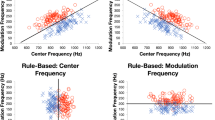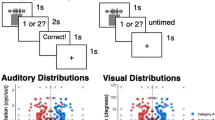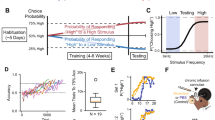Abstract
Categorical perception is a process by which a continuous stimulus space is partitioned to represent discrete sensory events. Early experience has been shown to shape categorical perception and enlarge cortical representations of experienced stimuli in the sensory cortex. The present study examines the hypothesis that enlargement in cortical stimulus representations is a mechanism of categorical perception. Perceptual discrimination and identification behaviors were analyzed in model auditory cortices that incorporated sound exposure-induced plasticity effects. The model auditory cortex with over-representations of specific stimuli exhibited categorical perception behaviors for those specific stimuli. These results indicate that enlarged stimulus representations in the sensory cortex may be a mechanism for categorical perceptual learning.










Similar content being viewed by others
Reference
Anderson, J. A., Silverstein, J. W., Ritz, S. A., & Jones, R. S. (1977). Distinctive features, categorical perception, and probability learning: some applications of a neural model. Psychological Review, 84, 413–451.
Bala, A. D., Spitzer, M. W., & Takahashi, T. T. (2003). Prediction of auditory spatial acuity from neural images on the owl's auditory space map. Nature, 424(6950), 771–774.
Bao, S., Chan, V. T., & Merzenich, M. M. (2001). Cortical remodelling induced by activity of ventral tegmental dopamine neurons. Nature, 412(6842), 79–83.
Bao, S., Chang, E. F., Woods, J., & Merzenich, M. M. (2004). Temporal plasticity in the primary auditory cortex induced by operant perceptual learning. Nature Neuroscience, 7(9), 974–981.
Beitel, R. E., Schreiner, C. E., Cheung, S. W., Wang, X., & Merzenich, M. M. (2003). Reward-dependent plasticity in the primary auditory cortex of adult monkeys trained to discriminate temporally modulated signals. Proceedings of the National Academy of Sciences of the United States of America, 100(19), 11070–11075.
Blake, D. T., Heiser, M. A., Caywood, M., & Merzenich, M. M. (2006). Experience-dependent adult cortical plasticity requires cognitive association between sensation and reward. Neuron, 52(2), 371–381.
Bornstein, M. H., Kessen, W., & Weiskopf, S. (1976). The categories of hue in infancy. Science, 191(4223), 201–202.
Brown, M., Irvine, D. R., & Park, V. N. (2004). Perceptual learning on an auditory frequency discrimination task by cats: association with changes in primary auditory cortex. Cerebral Cortex, 14(9), 952–965.
Burns, E. M., & Ward, W. D. (1978). Categorical perception–phenomenon or epiphenomenon: evidence from experiments in the perception of melodic musical intervals. Journal of the Acoustical Society of America, 63(2), 456–468.
Chang, E. F., & Merzenich, M. M. (2003). Environmental noise retards auditory cortical development. Science, 300(5618), 498–502.
Cherniak, C. (1990). The bounded brain: toward quantitive neuroanatomy. Journal of Cognitive Neuroscience, 2, 58–68.
Chowdhury, S. A., & Suga, N. (2000). Reorganization of the frequency map of the auditory cortex evoked by cortical electrical stimulation in the big brown bat. Journal of Neurophysiology, 83(4), 1856–1863.
Crozier, J. B. (1997). Absolute pitch: practice makes perfect, the earlier the better. Psychology of Music, 25, 110–119.
Dayan, P., & Abbott, L. F. (2001). Theoretical Neuroscience. Cambridge, MA: The MIT Press.
DeWeese, M. R., Wehr, M., & Zador, A. M. (2003). Binary spiking in auditory cortex. Journal of Neuroscience, 23(21), 7940–7949.
Edeline, J. M., & Weinberger, N. M. (1993). Receptive field plasticity in the auditory cortex during frequency discrimination training: selective retuning independent of task difficulty. Behavioral Neuroscience, 107(1), 82–103.
Ehret, G. (1992). Categorical perception of mouse-pup ultrasounds in the temporal domain. Animal Behaviour, 43(3), 409–416.
Ehret, G., & Haack, B. (1981). Categorical perception of mouse pup ultrasound by lactating females. Naturwissenschaften, 68(4), 208–209.
Eimas, P. D. (1974). Auditory and linguistic processing of cues for place of articulation by infants. Perception & Psychophysics, 16, 564–570.
Engineer, N. D., Percaccio, C. R., Pandya, P. K., Moucha, R., Rathbun, D. L., & Kilgard, M. P. (2004). Environmental enrichment im-proves response strength, threshold, selectivity, and latency of auditory cortex neurons. Journal of Neurophysiology, 92(1), 73–82.
Erickson, C. A., Jagadeesh, B., & Desimone, R. (2000). Clustering of perirhinal neurons with similar properties following visual experience in adult monkeys. Nature Neuroscience, 3(11), 1143–1148.
Freedman, D. J., Riesenhuber, M., Poggio, T., & Miller, E. K. (2001). Categorical representation of visual stimuli in the primate prefrontal cortex. Science, 291(5502), 312–316.
Fritz, J., Shamma, S., Elhilali, M., & Klein, D. (2003). Rapid task-related plasticity of spectrotemporal receptive fields in primary auditory cortex. Nature Neuroscience, 6(11), 1216–1223.
Goldstone, R. (1994). Influences of categorization on perceptual discrimination. Journal of Experimental Psychology General, 123(2), 178–200.
Green, D. M., & Swets, J. A. (1966). Singal detection theory and psychophysics. New York: Wiley.
Grier, J. B. (1971). Nonparametric indexes for sensitivity and bias: computing formulas. Psychological Bulletin, 75(6), 424–429.
Harnad, S. R. (1987). Categorical perception: the groundwork of cognition. Cambridge: Cambridge University Press.
Harnad, S. (2003). Categorical perception. In L. Nadel (Ed.), Encyclopedia of cognitive science. London: Macmillan.
Harnad, S., Hanson, S. J., & Lubin, J. (1991). Categorical perception and the evolution of supervised learning in neural nets. In L. Reeker (Ed.), Working Papers of the AAAI Spring Symposium on Machine Learning of Natural Language and Ontology. pp. 65–74. Standford, CA.
Holt, L. L., Lotto, A. J., & Diehl, R. L. (2004). Auditory discontinuities interact with categorization: implications for speech perception. Journal of the Acoustical Society of America, 116(3), 1763–1773.
Jazayeri, M., & Movshon, J. A. (2006). Optimal representation of sensory information by neural populations. Nature Neuroscience, 9(5), 690–696.
Kilgard, M. P., & Merzenich, M. M. (1998). Cortical map reorganization enabled by nucleus basalis activity. Science, 279(5357), 1714–1718.
Kilgard, M. P., Pandya, P. K., Vazquez, J., Gehi, A., Schreiner, C. E., & Merzenich, M. M. (2001). Sensory input directs spatial and temporal plasticity in primary auditory cortex. Journal of Neurophysiology, 86(1), 326–338.
Kluender, K. R., Diehl, R. L., & Killeen, P. R. (1987). Japanese quail can learn phonetic categories. Science, 237(4819), 1195–1197.
Kuhl, P. K., & Miller, J. D. (1975). Speech perception by the chinchilla: Voiced-voiceless distinction in alveolar plosive consonants. Science, 190(4209), 69–72.
Kuhl, P. K., & Padden, D. M. (1982). Enhanced discriminability at the phonetic boundaries for the voicing feature in macaques. Perception & Psychophysics, 32(6), 542–550.
Kuhl, P. K., & Padden, D. M. (1983). Enhanced discriminability at the phonetic boundaries for the place feature in macaques. Journal of the Acoustical Society of America, 73(3), 1003–1010.
Kuhl, P. K., Williams, K. A., Lacerda, F., Stevens, K. N., & Lindblom, B. (1992). Linguistic experience alters phonetic perception in infants by 6 months of age. Science, 255(5044), 606–608.
Lasky, R. E., Syrdal-Lasky, A., & Klein, R. E. (1975). VOT discrimination by four to six and a half month old infants from Spanish environments. Journal of Experimental Child Psychology, 20(2), 215–225.
Liberman, A. M., Harris, K. S., Hoffman, H. S., & Griffith, B. C. (1957). The discrimination of speech sounds within and across phoneme boundaries. Journal of Experimental Psychology, 54(5), 358–368.
Liberman, A. M., Cooper, F. S., Shankweiler, D. P., & Studdert-Kennedy, M. (1967). Perception of the speech code. Psychological Review, 74(6), 431–461.
Livingston, K. R., Andrews, J. K., & Harnad, S. (1998). Categorical perception effects induced by category learning. Journal of Experimental Psychology. Learning, Memory, and Cognition, 24(3), 732–753.
Luna, R., Hernandez, A., Brody, C. D., & Romo, R. (2005). Neural codes for perceptual discrimination in primary somatosensory cortex. Nature Neuroscience, 8(9), 1210–1219.
Ma, X., & Suga, N. (2003). Augmentation of plasticity of the central auditory system by the basal forebrain and/or somatosensory cortex. Journal of Neurophysiology, 89(1), 90–103.
MacKay, I. R., Flege, J. E., Piske, T., & Schirru, C. (2001). Category restructuring during second-language speech acquisition. Journal of the Acoustical Society of America, 110(1), 516–528.
Massaro, D. W. (1987). Categorical partition: A fussy logical model of categorical behavior. In S. Harnad (Ed.), Categorical perception: the groundwork of cognition. pp. 254–283, Cambridge, UK: Cambrige University Press.
Naatanen, R., Lehtokoski, A., Lennes, M., Cheour, M., Huotilainen, M., Iivonen, A., et al. (1997). Language-specific phoneme representations revealed by electric and magnetic brain responses. Nature, 385(6615), 432–434.
Nelson, D. A., & Marler, P. (1989). Categorical perception of a natural stimulus continuum: birdsong. Science, 244(4907), 976–978.
Ohl, F. W., & Scheich, H. (1996). Differential frequency conditioning enhances spectral contrast sensitivity of units in auditory cortex (field Al) of the alert Mongolian gerbil. European Journal of Neuroscience, 8(5), 1001–1017.
O’Kusky, J., & Colonnier, M. (1982). A laminar analysis of the number of neurons, glia, and synapses in the adult cortex (area 17) of adult macaque monkeys. Journal of Comparative Neurology, 210(3), 278–290.
Pantev, C., Oostenveld, R., Engelien, A., Ross, B., Roberts, L. E., & Hoke, M. (1998). Increased auditory cortical representation in musicians. Nature, 392(6678), 811–814.
Paradiso, M. A. (1988). A theory for the use of visual orientation information which exploits the columnar structure of striate cortex. Biological Cybernetics, 58(1), 35–49.
Pollack, L., & Norman, D. A. (1964). A non-parametric analysis of recognition experiments. Psychonomet Sci, 1, 125–126.
Polley, D. B., Heiser, M. A., Blake, D. T., Schreiner, C. E., & Merzenich, M. M. (2004). Associative learning shapes the neural code for stimulus magnitude in primary auditory cortex. Proceedings of the National Academy of Sciences of the United States of America, 101(46), 16351–16356.
Polley, D. B., Steinberg, E. E., & Merzenich, M. M. (2006). Perceptual learning directs auditory cortical map reorganization through top–down influences. Journal of Neuroscience, 26(18), 4970–4982.
Powell, M. J. D. (1977). A fast algorithm for nonlinearly constrained optimization calculations. In G. A. Watson (Ed.), Numerical analysis. New York: Springer.
Recanzone, G. H., Merzenich, M. M., Jenkins, W. M., Grajski, K. A., & Dinse, H. R. (1992). Topographic reorganization of the hand representation in cortical area 3b owl monkeys trained in a frequency-discrimination task. Journal of Neurophysiology, 67(5), 1031–1056.
Recanzone, G. H., Schreiner, C. E., & Merzenich, M. M. (1993). Plasticity in the frequency representation of primary auditory cortex following discrimination training in adult owl monkeys. Journal of Neuroscience, 13(1), 87–103.
Romo, R., Merchant, H., Zainos, A., & Hernandez, A. (1997). Categorical perception of somesthetic stimuli: psychophysical measurements correlated with neuronal events in primate medial premotor cortex. Cerebral Cortex, 7(4), 317–326.
Schoups, A., Vogels, R., Qian, N., & Orban, G. (2001). Practising orientation identification improves orientation coding in V1 neurons. Nature, 412(6846), 549–553.
Sengpiel, F., Stawinski, P., & Bonhoeffer, T. (1999). Influence of experience on orientation maps in cat visual cortex. Nature Neuroscience, 2(8), 727–732.
Seung, H. S., & Sompolinsky, H. (1993). Simple models for reading neuronal population codes. Proceedings of the National Academy of Sciences of the United States of America, 90(22), 10749–10753.
Steinschneider, M., Fishman, Y. I., & Arezzo, J. C. (2003). Representation of the voice onset time (VOT) speech parameter in population responses within primary auditory cortex of the awake monkey. Journal of the Acoustical Society of America, 114(1), 307–321.
Takeuchi, A. H., & Hulse, S. H. (1993). Absolute pitch. Psychological Bulletin, 113(2), 345–361.
Talwar, S. K., & Gerstein, G. L. (2001). Reorganization in awake rat auditory cortex by local microstimulation and its effect on frequency-discrimination behavior. Journal of Neurophysiology, 86(4), 1555–1572.
Wiesel, T. N. (1982). Postnatal development of the visual cortex and the influence of environment. Nature, 299(5884), 583–591.
Williams, L. (1977). The perception of stop consonant voicing by Spanish–English bilinguals. Perception & Psychophysics, 21, 289–297.
Wyttenbach, R. A., May, M. L., & Hoy, R. R. (1996). Categorical perception of sound frequency by crickets. Science, 273(5281), 1542–1544.
Zhang, K., Ginzburg, I., McNaughton, B. L., & Sejnowski, T. J. (1998). Interpreting neuronal population activity by reconstruction: unified framework with application to hippocampal place cells. Journal of Neurophysiology, 79(2), 1017–1044.
Zhang, L. I., Bao, S., & Merzenich, M. M. (2001). Persistent and specific influences of early acoustic environments on primary auditory cortex. Nature Neuroscience, 4(11), 1123–1130.
Acknowledgements
The work was supported by a grant from US National Institute of Health.
Author information
Authors and Affiliations
Corresponding author
Additional information
Action Editor: Shihab Shamma
Rights and permissions
About this article
Cite this article
Kim, H., Bao, S. Distributed representation of perceptual categories in the auditory cortex. J Comput Neurosci 24, 277–290 (2008). https://doi.org/10.1007/s10827-007-0055-5
Received:
Revised:
Accepted:
Published:
Issue Date:
DOI: https://doi.org/10.1007/s10827-007-0055-5




